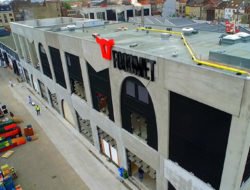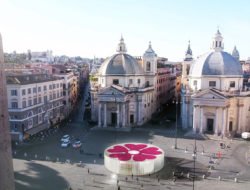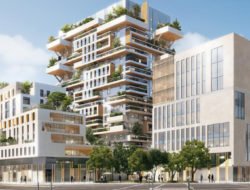What if it would be possible to breathe better thanks to organic facades? Challenge accepted by the city of Hangzhou, the first city to build towers that will produce oxygen and get rid of CO2.
Chinese metropolises regularly face periods of ‘airpocalypse’, during which they suffer from dense fogs impregnated with toxic micro-particles. The city of Hangzhou, however, is now getting everything ready for one of its first regenerative architectural projects. It will build four glass towers that can produce oxygen and at the same time, absorb CO2.
At the heart of this revolution: organic facades in algae, manufactured by the French firm XTU Architects. The great love of architect Anouk Legendre has an impossible name: Haematococcus pluvialis. It is a microalga which colour changes from light green to vermillion when its environment becomes hostile. This molecule is also a powerful antioxidant that is already very popular in pharmaceutical laboratories. Currently grown in a kind of flat and vertical factory, made of narrow aquariums, it could in the near future grow on buildings and clean up the site.
Green gold
When exposed to the sun, these microscopic plants can both reduce the energy consumption of the building, transforming CO2 into oxygen, and produce complex molecules, such as proteins or edible spirulina. “Our organic facades are some kind of vertical fields, says Anouk Legendre, an ecological architect at XTU. Between two glass walls, we ‘grow’ micro-algae that insulate and produce heat when it is cold and vice versa. The whole is a closed circuit, immune to any contamination, and which also benefits from the temperature of the building. It requires little energy for its thermal regulation.
Chinese science fiction? After seven years of R&D, XTU has become a world reference in the field. Recently, the firm has won a residential project of 1,000 m2 for the contest “Reinventing Paris”. Twice patented, labelled by the competitive cluster Cosmetic Valley, its organic facade will decorate one of the buildings of the complex In Vivo, designed for Paris Rive gauche. “Before, Hangzhou, this will be the first residential building in the world built using this process“, explains Anouk Legendre. Still, for the time being, the facade is (very) expensive: 2,500 euros per square metre, including the hydraulic structure. After black gold, here’s green gold. With an impossible name: Haematococcus pluvialis.
Tags: algae, architecture, China, Hangzhou, organic facade, XTU






































